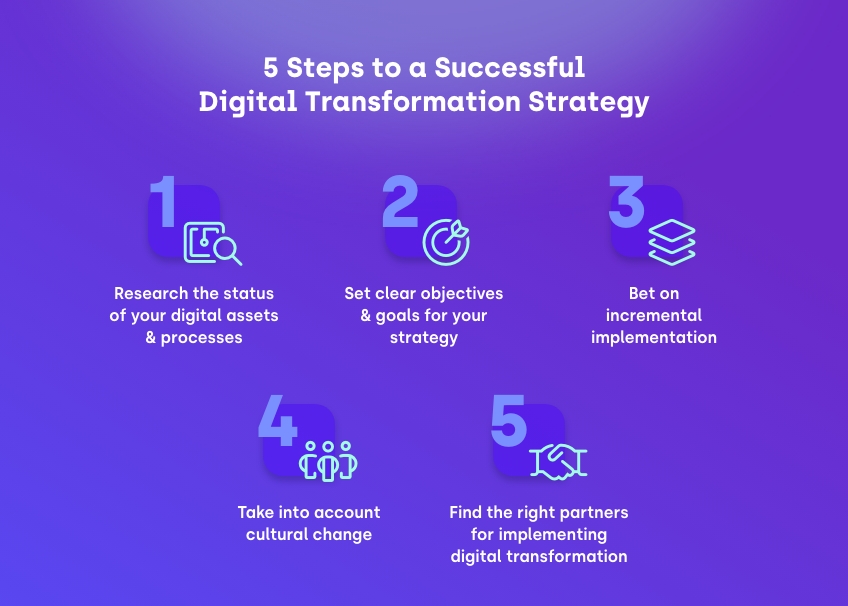
Implementing digital transformation
Digital technologies have changed every aspect of the way we live and work — and companies are racing to implement new digital solutions and business processes to thrive and stay competitive and up-to-date with market trends.

The reasons for embracing the digital are numerous: a massive boost in innovation, maximization of operational costs, new business opportunities, higher customer satisfaction, and, ultimately, revenue growth. Having these in mind, it’s no wonder that worldwide spending on digital transformation is expected to reach $3.4 trillion by 2026.
Implementing digital transformation, however, doesn’t happen overnight. Considering the specific business model, it needs to be a well-planned and structured process. Its embedding in an organization should be executed thoughtfully and in incremental steps.
The successful transformation of an organization is not simply a process of digitization of paper documents or a process of digitalizing processes. Digital transformation is a wholesome change in most aspects of how a business operates — and even how its team members think about their day-to-day tasks.
That’s why adopting a sound strategy for your digital transformation is crucial. Your organization needs to have a digital transformation roadmap based on its long-term goals so that these can be cross-matched with how technology can boost strategic initiatives.
5 Steps to a successful digital transformation strategy
The recipes for implementing digital transformation would vary for different kinds of businesses. At the same time, some tried-and-true tips apply to all organizations. Here they are.

1. Research the status of your digital assets and processes
It starts with a solid assessment of where your company is currently in digitization and digitalization. Once you’ve executed that evaluation, the next step is investigating where your technological deficiencies are.
Don’t forget to consider digital transformation in terms of people, processes, and technology. They are the heart of your organization, so any transformation effort has to start with evaluating how well they are interacting and how far you dare to dream that their synergy can reach.
2. Set clear objectives and goals for your strategy
Where do you want your organization to get after implementing digital transformation? You should envision a clear picture to set your digital transformation goals in writing.
Such a strategy’s typical long-term objectives include finding new revenue models, adapting to the ever-changing market environment, improving customer satisfaction, and boosting revenue.
At the same time, it’s also important to set mid-term goals for the different stages of the transformation process and define what digital tools will help you get there. These would help guide your efforts and allow you to check regularly if you’re progressing according to your digital transformation plan.
3. Bet on incremental implementation
Rather than planning for an overnight overhaul — or a one-time “digital transformation sprint”, think about digital transformation as a marathon with multiple sprints.
While there are tasks that have to be launched massively at once, many of the elements of your digital transformation plan can be executed through pilot projects. This gives room for adapting and testing what works and what doesn’t. Then through incremental changes, you can use the parts that have clicked well as building blocks.
The incremental implementation bets on identifying and addressing innovation gaps on the go. It requires a shift towards agility — and not sticking to rigid plans, even though plans are made in advance.
4. Don’t forget about cultural change
Even with the best digital technology in place and with the most advanced artificial intelligence in operation, your digital transformation will be as successful as the level of your employees’ involvement in its implementation. Getting team members on board in your digital transformation roadmap is essential.
How team members work and think about their projects and tasks changes dramatically when digital methods are introduced. To enable the appearance of a new digital transformation culture in your organization, you should give enough space for learning and experimentation. Adequate and timely communication is also crucial, so you can keep everybody updated and feel part of the process rather than simply bystanders. Hiring a Chief Digital Officer who can help boost these efforts is a good idea.
5. Find the right partners for implementing digital transformation
Business leaders often seek partnerships to execute projects and boost productivity and innovation. This is especially important in digital transformation because the process is complex and multifaceted, while available digital tools are numerous.
The good news is that you’re not expected to be an expert on digital transformation since there are dedicated specialists in the field. It’s just a matter of setting your goals and looking for a digital transformation partner who can help you achieve them most meaningfully.
Resolute Software can help you implement digital transformation
For many organizations, getting started with digital transformation seems like a gigantic task that’s difficult to tackle. You’re not alone on this path, though — and getting on board a trustworthy partner like Resolute Software is your key to success.
Our experts have immense experience in helping companies on their digital transformation journey. We’ve become the trusted partner of hundreds of organizations with success stories worldwide.
If you’re ready to start your digital transformation initiatives, get in touch with us to learn how Resolute Software can boost your digital transformation efforts and help direct your business to success.
FAQs
Executing digital transformation in an organization entails strategically embedding digital technologies in the business processes intending to optimize operations and drive revenue growth.
While there are numerous ways to implement a digital transformation, the best approach for business leaders is to start with a strategic roadmap that aligns with the organization’s goals and vision and introduces relevant new business models.
The five steps to crafting a successful digital implementation strategy include establishing the current status of digital assets and processes, creating clear goals, incremental implementation, focusing on cultural change, and getting the right partners on board. Following each step meticulously sets an organization on its path to a complete digital transformation in line with its business strategy.




